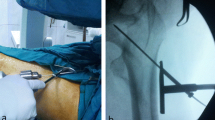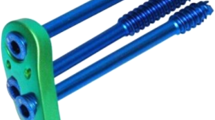Abstract
Intertrochanteric hip fractures are common orthopaedic injuries and the incidence is growing with increasing life expectancy. Several randomized controlled studies have shown the advantages of intramedullary devices over hip screw fixation in unstable intertrochanteric fractures. However, the proven advantage of the intramedullary device in stable intertrochanteric fractures, OTA (Orthopaedic Trauma Association) classification 31-A1 and some 31-A2 fractures are in less blood loss compared with standard hip screw fixation. In the current technical note, we describe a novel minimally invasive technique of hip screw fixation that use a keyhole size incision to fix stable intertrochanteric fractures using sliding hip screw. The less invasive nature and potentially reduced blood loss makes this technique an attractive option for stabilizing stable intertrochanteric hip fractures.







Similar content being viewed by others
References
Sharma A, Sethi A, Sharma S (2017) Treatment of stable intertrochanteric fractures of the femur with proximal femoral nail versus dynamic hip screw: a comparative study. Rev Bras Ortop 53(4):477–481. https://doi.org/10.1016/j.rboe.2017.07.008
Zuckerman, J. D. (Ed.). (1990). Comprehensive care of orthopaedic injuries in the elderly. Urban & Schwarzenberg.
Evans, E. M. (1949). The treatment of trochanteric fractures of the femur. Journal of Bone and Joint Surgery. American Volume, 31B(2), 190–203.
Boyd, H. B., & Griffin, L. L. (1949). Classification and treatment of trochanteric fractures. Archives of Surgery, 58(6), 853–866.
Kyle, R. F., Gustilo, R. B., & Premer, R. F. (1979). Analysis of six hundred and twenty-two intertrochanteric hip fractures. Journal of Bone and Joint Surgery. American Volume, 61(2), 216–221.
Gotfried, Y. (2004). The lateral trochanteric wall: A key element in the reconstruction of unstable pertrochanteric hip fractures. Clinical Orthopaedics and Related Research, 425, 82–86.
Marsh, J. L., Slongo, T. F., Agel, J., et al. (2007). Fracture and dislocation classification compendium—2007: Orthopaedic Trauma Association classification, database and outcomes committee. Journal of Orthopaedic Trauma, 21(10), S1-133.
Schipper, I. B., Marti, R. K., & van der Werken, C. (2004). Unstable trochanteric femoral fractures: Extramedullary or intramedullary fixation. Review of literature. Injury, 35(2), 142–151.
Ziran, B. H., Heckman, D. S., Olarte, C. M., Chou, K., & Baranick, J. (2009). Intramedullary hip screw versus standard compression hip screw: Early postoperative rehabilitation comparisons. Orthopedics, 32(2), 83.
Barton, T. M., Gleeson, R., Topliss, C., Greenwood, R., Harries, W. J., & Chesser, T. J. (2010). A comparison of the long gamma nail with the sliding hip screw for the treatment of AO/OTA 31–A2 fractures of the proximal part of the femur: A prospective randomized trial. Journal of Bone and Joint Surgery. American Volume, 92(4), 792–798.
Utrilla, A. L., Reig, J. S., Munoz, F. M., & Tufanisco, C. B. (2005). Trochanteric gamma nail and compression hip screw for trochanteric fractures: A randomized, prospective, comparative study in 210 elderly patients with a new design of the gamma nail. Journal of Orthopaedic Trauma, 19(4), 229–233.
Pajarinen, J., Lindahl, J., Michelsson, O., Savolainen, V., & Hirvensalo, E. (2005). Pertrochanteric femoral fractures treated with a dynamic hip screw or a proximal femoral nail. A randomised study comparing post-operative rehabilitation. Journal of Bone and Joint Surgery. British Volume, 87(1), 76–81.
Parker, M. J., & Handoll, H. H. (2008). Gamma and other cephalocondylic intramedullary nails versus extramedullary implants for extracapsular hip fractures in adults. The Cochrane Database of Systematic Reviews, 3, CD000093.
Shah, N. H., Walton, N. P., Sudhahar, T. A., & Donell, S. T. (2004). Screening time for extra-capsular proximal femoral fracture fixation; the difference between extra-medullary and intra-medullary implant usage. Injury, 35(10), 1010–1014.
Lee, Y. S., Huang, H. L., Lo, T. Y., & Huang, C. R. (2007). Dynamic hip screw in the treatment of intertrochanteric fractures: A comparison of two fixation methods. International Orthopaedics, 31(5), 683–688.
Wong, T. C., Chiu, Y., Tsang, W. L., Leung, W. Y., & Yeung, S. H. (2009). A double-blind, prospective, randomised, controlled clinical trial of minimally invasive dynamic hip screw fixation of intertrochanteric fractures. Injury, 40(4), 422–427.
Kosygan, K. P., Mohan, R., & Newman, R. J. (2002). The Gotfried percutaneous compression plate compared with the conventional classic hip screw for the fixation of intertrochanteric fractures of the hip. Journal of Bone and Joint Surgery. British Volume, 84(1), 19–22.
Leung, W. Y., & Tsang, W. L. (2008). Conventional muscle-reflection approach versus mini-incision muscle-splitting approach in dynamic hip screw fixation. Journal of Orthopaedic Surgery (Hong Kong), 16(2), 156–161.
Peyser, A., Weil, Y. A., Brocke, L., et al. (2007). A prospective, randomised study comparing the percutaneous compression plate and the compression hip screw for the treatment of intertrochanteric fractures of the hip. Journal of Bone and Joint Surgery. British Volume, 89(9), 1210–1217.
DiPaola, M., Rozbruch, S. R., & Helfet, D. L. (2004). Minimal incision technique using a two-hole plate for fixation of stable intertrochanteric hip fractures. Orthopedics, 27(3), 270–274.
Alobaid, A., Harvey, E. J., Elder, G. M., Lander, P., Guy, P., & Reindl, R. (2004). Minimally invasive dynamic hip screw: Prospective randomized trial of two techniques of insertion of a standard dynamic fixation device. Journal of Orthopaedic Trauma, 18(4), 207–212.
Funding
None.
Author information
Authors and Affiliations
Corresponding author
Ethics declarations
Conflict of Interest
None of the authors have any conflicts to declare.
Ethical Standard Statement
This article does not contain any studies with human or animal subjects performed by any of the authors.
Informed Consent
For this type of study informed consent is not required.
Additional information
Publisher's Note
Springer Nature remains neutral with regard to jurisdictional claims in published maps and institutional affiliations.
Rights and permissions
About this article
Cite this article
Shivashankar, B., Shah, S., Kumar, G. et al. Keyhole Sliding Hip Screw Fixation for Stable Intertrochanteric Hip Fractures: A Novel Technique. JOIO 56, 1101–1107 (2022). https://doi.org/10.1007/s43465-022-00624-5
Received:
Accepted:
Published:
Issue Date:
DOI: https://doi.org/10.1007/s43465-022-00624-5




